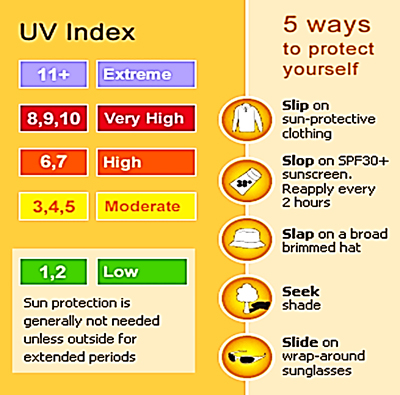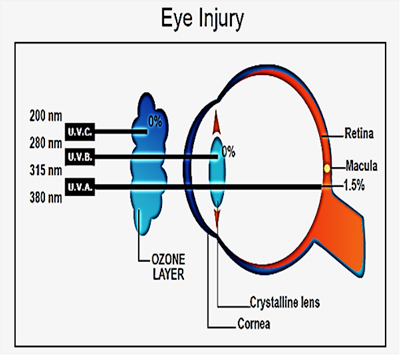Will it be sunny or cloudy? Probability of rain? The forecast is some of the first data we consult at the start of the day. Based on it, we decide how to dress, whether or not take an umbrella and even consider outdoor plans. Most of the time we ignore the existence or relevance of another index as important and accessible: UV RADIATION.
Since the beginning of the 70’s, there has been an increase in skin cancer cases, due to exposure to UV light rays, especially in places with a majority population with light skin and eyes. The World Health Organization (WHO) uses the term "epidemic" to qualify the significant increase in the number of new cases of UV exposure damage in recent years, one of the leading causes of mortality at the global level.
Today ultraviolet radiation is a real threat to health. Although, we have already seen many articles about ultraviolet light, it is important to define the three groups of wavelengths and understand the differences between them.
To begin, we have to be mindful that continuous exposure to ultraviolet radiation from the sun happens to all of us constantly. The more detailed information we have about UV rays, the more we can work on protection. It is true that in small doses on the skin, UV rays have certain beneficial properties, such as the synthesis of vitamin D, but ultraviolet radiation has been identified as a risk factor in the appearance of certain ocular pathologies, such as photophthalmia, pterygium, pinguecula, band keratopathy, cataracts or macular degeneration associated with age.

Figure A- UV Index Scale, image from www.scfa.edu.au
It is known as solar radiation, the set of electromagnetic radiations emitted by the sun, which are distributed from infrared to ultraviolet, classifying this last one in three main categories, ultra violet waves type A (UV-A), ultra violet waves type B (UV-B) and ultra violet waves type C (UV-C), according to their wavelengths. However, not all radiation reaches the earth's surface, because the shorter ultraviolet waves are absorbed by the ozone layer.
The ozone layer has weakened and allows the entry of high levels of ultraviolet (UV) radiation. The intensity of the radiation depends on cloud cover and the angle of the sun in reference to the earth. The deterioration of the ozone layer, allows greater passage of UV-B waves, which are harmful to the eyes and health in general. UV radiation is highly variable in time and space. The activities of humans, resulting in air pollution and destruction of the ozone, affect the atmosphere and influence UV radiation that reaches Earth.
The human cornea absorbs all the UV below 280 nm. Above this wavelength there is a rapid increase in transmission up to 320 nm. It is important to consider that although the corneal epithelium comprises 10% of the thickness of the cornea, it has the highest absorption for the UV-A band (315 to 400nm). This is due to the high content of proteins and nucleic acid present in the epithelial cells.

Figure B- UV in relation to atmosphere, image from http://climatebits.umd.edu
To avoid harmful effects on eye health from exposure to high levels of ultraviolet radiation, it is essential to use polarized ophthalmic lenses. The protection provided by sunglasses depends on the materials, coatings and photo-protective filters they have. During the exam and with recommendations from an ECP, patients can learn about the UV transmittance of ophthalmic materials. According to FDA (Food and Drug Administration, USA) requirements, polycarbonate sunglasses photochromic lenses and polarized meet protection levels.
The World Health Organization estimates that our eyes receive 80 % of our lifetime exposure to UV from the sun before the age of 18. The eye is protected naturally when UV radiation is not very intense or does not last long. The cornea and lens absorb UVB rays, and 98% of low UVA rays in reasonable conditions. Excessive exposure can cause severe, irreversible eye damage.
Since exposure to UV light damages the eye and is cumulative during a person's life, all possible efforts to obtain lenses that offer maximum UV protection are necessary. The fact that a lens is dark does not mean that it has UV protection. On the contrary, it can mean a greater risk for the user because the dark color causes the pupil to dilate, allowing more light and UV radiation to pass into the eye. That's why 100 percent protection against UV rays every day gains more importance in preventing macular degeneration or the development of cataracts or other conditions.
The filtration of UV radiation exerted inside the ocular is independent of the degree of dye. So darker lenses are not necessarily giving us good vision, protecting us from UV or cutting glare. We also have to consider peripheral light that could affect the eye, even when 100% UV protection lenses are worn. Sunglasses that incorporate lateral protection into their designs are the only ones that completely protect us from UV radiation, since they also protect us from peripheral radiation.
What is Polarization?
Let’s keep it simple. Sunlight travels in all directions; we know that. When sunlight is reflected on a horizontal surface, such as a road, water, metallic or white surface, the result is intense polarization in the horizontal plane.
Vertical light is useful for the human eye. It allows us to see colors and contrasts, while concentrated horizontal light creates a reflection or noise optic, which reduces visibility and creates a potentially dangerous situation due to lack of contrast. Polarized lenses have a vertical alignment filter that blocks horizontally polarized light and UV light efficiently, making them useful for driving or fishing.

Image from https://iristech.co
There is a high degree of unfamiliarity with the damage that UV radiation can cause to our eyes. It is important to make patients aware of the need to protect their eyes, since UV radiation is directly related to the appearance of serious pathologies such as photophthalmia, pterygium, pinguecula, band keratopathy, cataracts and MD, not to mention skin problems, and some of these damages are irreversible.
It is worth mentioning that not only polarized lenses provide UV protection, now there are contact lenses that protect the eye from harmful UV rays, too. It is important to know work activity, sports, recreational, pharmacological, history of pathologies and surgical interventions when assessing the risks of exposure to UV radiation.
Incident ultraviolet radiation depends on several factors: altitude, latitude, solar angulation, cloudiness, reflection from soil and the presence of aerosols or polluting substances in the atmosphere. Polarized sunglasses and polycarbonate sunglasses satisfy FDA requirements for incident UV protection as well.













